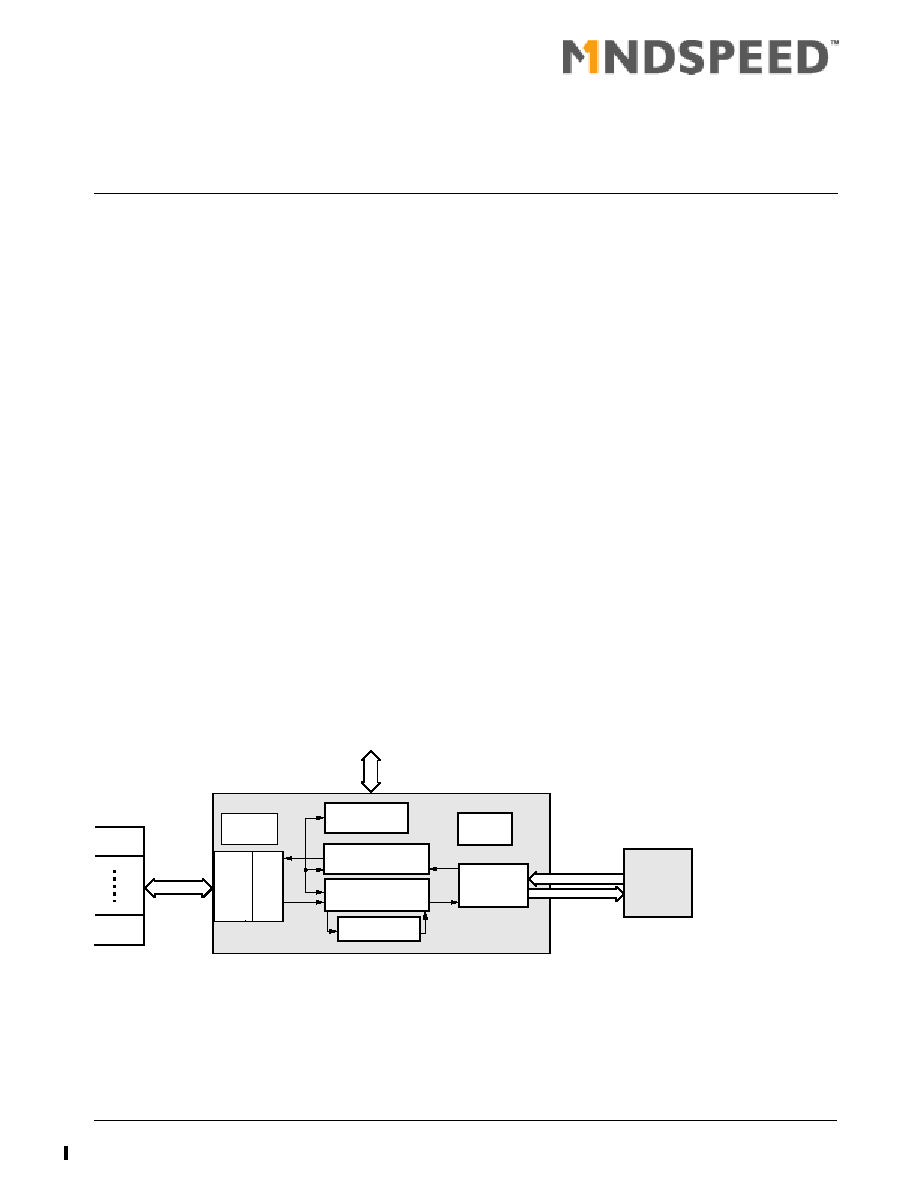
Data Sheet
28236-DSH-001-B
May 2003
CN8236
ATM ServiceSAR Plus with xBR Traffic Management
The CN8236 Service Segmentation and Reassembly Controller integrates ATM terminal
functions, PCI Bus Master and Slave controllers, and a UTOPIA level 1 or 2 interface
with service-specific functions in a single package for AAL0, 3/4, and 5 operations.
The ServiceSAR Controller generates and terminates ATM traffic and automatically
schedules cells for transmission. The CN8236 is targeted at 155 Mbps throughput
systems where the number of VCCs is relatively large, or the performance of the overall
system is critical. Examples of such networking equipment include Routers, Ethernet
switches, ATM Edge switches, or Frame Relay switches.
Service-Specific Performance Accelerators
The CN8236 incorporates numerous service-specific features designed to accelerate
and enhance system performance. As examples, the CN8236 implements Echo
Suppression of LAN traffic via LECID filtering, and supports Frame Relay DE to CLP
interworking.
Advanced xBR Traffic Management
The xBR Traffic Manager in the CN8236 supports multiple ATM service categories. This
includes CBR, VBR (both single and dual leaky bucket), UBR, GFR (Guaranteed Frame
Rate), and ABR. The CN8236 manages each VCC independently. It dynamically
schedules segmentation traffic to comply with up to 16+CBR user-configured
scheduling priorities for the various traffic classes. Scheduling is controlled by a
Schedule table configured by the user and based on a user-specified time reference.
ABR channels are managed in hardware according to user-programmable ABR
templates. These templates tune the performance of the CN8236's ABR algorithms to a
specific system's or network's requirements.
≠Continued≠
Functional Block Diagram
Multi-client
PCI Bus
Timer
Counters
Local Bus
PCI
Master/
Slave
DMA
Co-
Proc'r
Local Memory
Interface
Segmentation
Coprocessor
Reassembly
Coprocessor
CBR, VBR, ABR,
UBR, GFR
Traffic Manager
Patent Pending
Rx/Tx
UTOPIA
Master/Slave
Control/
Status
CN8236
CN8250
PHY
Device
Cell
FIFO
Distinguishing Features
Service-Specific Performance
Accelerators
∑
LECID filtering and echo suppression
∑
Dual leaky bucket based on CLP
(frame relay)
∑
Frame relay DE interworking
∑
Internal SNMP MIB counters
∑
IP over ATM; supports both CLP0+1
and ABR shaping
Flexible Architectures
∑
Multi-peer host
∑
Direct switch attachment via reverse
UTOPIA
∑
ATM terminal
≠ Host control
≠ Local bus control
∑
Optional local processor
≠Continued≠

© 1999-2003,
Mindspeed TechnologiesTM, a Conexant business
All Rights Reserved.
Information in this document is provided in connection with Mindspeed Technologies ("Mindspeed") products. These materials are
provided by Mindspeed as a service to its customers and may be used for informational purposes only. Mindspeed assumes no
responsibility for errors or omissions in these materials. Mindspeed may make changes to specifications and product descriptions at
any time, without notice. Mindspeed makes no commitment to update the information and shall have no responsibility whatsoever for
conflicts or incompatibilities arising from future changes to its specifications and product descriptions.
No license, express or implied, by estoppel or otherwise, to any intellectual property rights is granted by this document. Except as
provided in Mindspeed's Terms and Conditions of Sale for such products, Mindspeed assumes no liability whatsoever.
THESE MATERIALS ARE PROVIDED "AS IS" WITHOUT WARRANTY OF ANY KIND, EITHER EXPRESS OR IMPLIED, RELATING
TO SALE AND/OR USE OF MINDSPEED PRODUCTS INCLUDING LIABILITY OR WARRANTIES RELATING TO FITNESS FOR A
PARTICULAR PURPOSE, CONSEQUENTIAL OR INCIDENTAL DAMAGES, MERCHANTABILITY, OR INFRINGEMENT OF ANY
PATENT, COPYRIGHT OR OTHER INTELLECTUAL PROPERTY RIGHT. MINDSPEED FURTHER DOES NOT WARRANT THE
ACCURACY OR COMPLETENESS OF THE INFORMATION, TEXT, GRAPHICS OR OTHER ITEMS CONTAINED WITHIN THESE
MATERIALS. MINDSPEED SHALL NOT BE LIABLE FOR ANY SPECIAL, INDIRECT, INCIDENTAL, OR CONSEQUENTIAL
DAMAGES, INCLUDING WITHOUT LIMITATION, LOST REVENUES OR LOST PROFITS, WHICH MAY RESULT FROM THE USE
OF THESE MATERIALS.
Mindspeed products are not intended for use in medical, lifesaving or life sustaining applications. Mindspeed customers using or
selling Mindspeed products for use in such applications do so at their own risk and agree to fully indemnify Mindspeed for any
damages resulting from such improper use or sale.
The following are trademarks of Conexant Systems, Inc.: Mindspeed TechnologiesTM, the MindspeedTM logo, and "Build It First"TM.
Product names or services listed in this publication are for identification purposes only, and may be trademarks of third parties.
Third-party brands and names are the property of their respective owners.
For additional disclaimer information, please consult Mindspeed Technologies Legal Information posted at
www.mindspeed.com
which is incorporated by reference.
28236-DSH-001-B
Mindspeed Technologies
TM
Ordering Information
Document Revision History
Model Number
Manufacturing
Part Number
Product Revision
Package
Operating
Temperature
CN8236
28236-12
B
388-pin BGA
≠40
∞
C to 85
∞
C
CN8236/
CX28250EVM
Evaluation
Module
BT00-D700-601
--
--
--
Document Number
Device Revision
Comments
N8236DSA
CN8236 Rev. A
This is the advanced issue of the data sheet.
100453B
CN8236 Rev. B
Put into new Conexant format.
500372A
CN8236 Rev. B
Revisions made. Changed format from Conexant to Mindspeed.
500372B
CN8236 Rev. B
Corrections as noted by change bars.
28236-DSH-001-A
CN8236 Rev. B
Corrections as noted by change bars.
28236-DSH-001-B
CN8236 Rev. B
Corrections as noted by change bars.

28236-DSH-001-B
Mindspeed Technologies
TM
≠Continued Distinguishing Features≠
New Features
∑
3.3 V, 388 BGA lowers power and
eases PCB assembly
∑
AAL3/4 CPCS generation and
checking
∑
PCI 2.1, including support for serial
EEPROM
∑
Enhancements to xBR Traffic
Manager
≠ fewer ABR templates
≠ improved CBR tunneling
∑
Reduced memory size for VCC
lookup tables
∑
Increased addressing flexibility
∑
Additional byte lane swappers for
increased system flexibility
∑
UTOPIA level 2, 8/16 bit 50 MHz
∑
Programmable size routing tags up
to 64 byte cells
∑
Selectable single/separate UTOPIA
clocks
∑
Interworking function for AAL1 and 2
scheduling
≠ Cell on demand scheduling
∑
Updated PM-OAM processing per i.610
∑
SECBC calculated per GR-1248
∑
Paging function in order to gluelessly
control RS8228 cell delineator (SAR
provides power)
∑
Robust EEPROM operation
∑
Compact PCI Hot Swap capabilities
∑
Master PCI write over read arbitration
control
∑
Increase incoming DMA FIFO buffer
from 2 kB to 8 kB
∑
Prepended VCC index on RSM BOM
cells
∑
Optional reference clock drive
scheduler
∑
Head of Line Flushing (HoLF)
mechanism
∑
Internal loopback in multiPHY mode
∑
Programmable number of slots that
the scheduler can fall behind
xBR Traffic Management
∑
TM4.1 Service Classes
≠ CBR
≠ VBR (single, dual and CLP-based
leaky buckets)
≠ Real time VBR
≠ ABR
≠ UBR
≠ GFC (controlled & uncontrolled
flows)
≠ Guaranteed Frame Rate (GFR)
(guaranteed MCR on UBR VCCs)
∑
16 levels of priorities (16 + CBR)
∑
Dynamic per-VCC scheduling
∑
Multiple programmable ABR
templates (supplied by Mindspeed or
user)
∑
Scheduler driven by selectable clock
≠ Local system clock
≠ External reference clock
∑
Internal RM OAM cell feedback path
∑
Virtual FIFO buffer rate matching
(Source Rate Matching)
∑
Per-VCC MCR and ICR
∑
Tunneling
≠ VP tunnels (VCI interleaving on
PDU boundaries)
≠ CBR tunnels (cells interleaved as
UBR, VBR or ABR with an
aggregate CBR limit)
∑
155 Mbps full duplex (two cell PDUs)
Multi-Queue Segmentation Processing
∑
32 transmit queues with optional
priority levels
∑
64 K VCCs maximum
∑
AAL5 and AAL3/4 CPCS generation
∑
AAL0 Null CPCS (optional use of PTI
for PDU demarcation)
∑
ATM cell header generation
∑
Raw cell mode (52 octet)
∑
200 Mbps half duplex
∑
155 Mbps full duplex (w/ 2-cell PDUs)
∑
Variable length transmit FIFO buffer -
CDV - host latency matching (one to
nine cells)
∑
Symmetric Tx and Rx architecture
≠ buffer descriptors
≠ queues
∑
User defined field circulates back to
the host (32 bits)
∑
Distributed host or SAR-shared
memory segmentation
∑
Simultaneous segmentation and
reassembly
∑
Per-PDU control of CLP/PTI (UBR)
∑
Per-PDU control of AAL5 UU field
∑
Message and streaming status
modes
∑
Virtual Tx FIFO buffer (PCI host)
Multi-Queue Reassembly Processing
∑
32 reassembly queues
∑
64 K VCCs maximum *
∑
AAL5 and AAL3/4 CPCS checking
∑
AAL0
≠ PTI termination
≠ Cell count termination
∑
Early Packet Discard, based on:
≠ Receive buffer underflow
≠ Receive status overflow
≠ CLP with priority threshold
≠ AAL5 max PDU length
≠ Rx FIFO buffer full
≠ Frame relay DE with priority
threshold
≠ LECID filtering and echo
suppression
≠ Per-VCC firewalls
∑
Dynamic channel lookup (NNI or UNI
addressing)
≠ Supports full address space
≠ Deterministic
≠ Flexible VCI count per VPI
≠ Optimized for signalling address
assignment
∑
Message and streaming status
modes
∑
Raw cell mode (52 octet)
∑
200 Mbps half duplex
∑
155 Mbps full duplex (w/ 2-cell
PDUs)
∑
Distributed host or SAR-shared
memory reassembly
∑
Eight programmable reassembly
hardware time-outs (per-VCC
assignable)
∑
Global max PDU length for AAL5
∑
Per-VCC buffer firewall (memory
usage limit)
∑
Simultaneous reassembly and
segmentation
∑
Idle cell filtering
High Performance Host Architecture
with Buffer Isolation
∑
Write-only control and status
∑
Read multiple command for data
transfer
∑
Up to 32 host clients control and
status queues
∑
Physical or logical clients
≠ Enables peer-to-peer architecture
∑
Descriptor-based buffer chaining
∑
Scatter/gather DMA
∑
Endian neutral (allows data word and
control word byte swapping, for both
big and little endian systems)
∑
Non-word (byte) aligned host buffer
addresses
∑
Automatically detects presence of Tx
data or Rx free buffers
∑
Virtual FIFO buffers (PCI bursts
treated as a single address)
∑
Hardware indication of BOM
∑
Allows isolation of system resources
∑
Status queue interrupt delay
Designer Toolkit
∑
Evaluation hardware and software
∑
Reference schematics
∑
Hardware Programming
Interface-RS823xHPI reference
source code (C)
≠Continued≠




